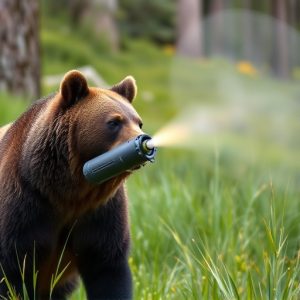Capsaicin’s Role: Unlocking Bear Spray’s Effective Deterrent Range
Bear spray, a potent pepper spray with capsaicin concentrations ranging from 20% to 35%, is an effec…….
Bear spray, a potent pepper spray with capsaicin concentrations ranging from 20% to 35%, is an effective deterrent against aggressive bears. This active ingredient, derived from chili peppers, temporarily disorients and blinds bears, allowing users to escape or find cover. Choosing the right bear spray involves understanding canister size, capsaicin concentration, and spray patterns for optimal protection at various distances. With proper usage and awareness of local regulations, bear spray significantly reduces conflicts in bear country.
- Understanding Bear Spray: What It Is and How It Works
- The Science Behind Capsaicin: Unlocking the Active Ingredient
- Deciphering Can Sizes and Spray Patterns
- Factors Influencing Effective Range: A Comprehensive Look
- Real-World Applications: Success Stories and Best Practices
Understanding Bear Spray: What It Is and How It Works
Bear spray, also known as bear repellent, is a specialized pepper spray designed to deter aggressive bears when outdoors in bear country. Unlike traditional pepper spray used for self-defense against humans, bear spray contains a high concentration of capsaicin, the active ingredient found in chili peppers. This potent compound irritates the eyes, nose, and respiratory system of bears, temporarily disorienting them and enabling you to escape or take cover.
The effectiveness of bear spray lies in its capsaicin concentration—typically ranging from 20% to 34%. This high level of capsaicin ensures that even at close range, a bear’s reaction is likely to be enough to deter an attack. However, it’s crucial to remember that bear spray is not 100% reliable and should only be used as a last resort when faced with an imminent threat from an aggressive bear. Proper usage techniques, such as aiming for the bear’s face and eyes, are essential for maximizing its deterrent range and success rate.
The Science Behind Capsaicin: Unlocking the Active Ingredient
The Science Behind Capsaicin: Unlocking the Active Ingredient
Bear spray, a popular deterrent for encounters with aggressive bears, relies on an active ingredient known as capsaicin. This compound is derived from chili peppers and is responsible for the burning sensation associated with spicy foods. In bear repellent products, capsaicin concentration plays a crucial role in determining its effectiveness. Typically, higher concentrations of capsaicin ensure greater potency against bears.
The capsaicin in bear spray interacts with the bear’s olfactory system, specifically targeting sensory cells in their nasal membranes and eyes. This irritation disrupts communication between neurons, leading to pain and temporary blindness. With this disruption, bears are often deterred from approaching or attacking potential threats, offering hikers and outdoor enthusiasts valuable time to escape or defend themselves.
Deciphering Can Sizes and Spray Patterns
When considering bear spray as a deterrent, one must understand that not all products are created equal. Deciphering can sizes and spray patterns is key to effective use. The size of the canister indicates its capacity, with larger cans holding more spray for extended use. However, it’s the capsaicin concentration—the active ingredient in bear repellent—that truly matters. Higher concentrations disrupt bears’ sense of smell, creating a safer distance between you and potential danger.
Spray patterns also vary, typically categorized as cone or jet. A cone pattern sprays in a wide angle, covering a larger area, which is ideal for quick application during a surprise encounter. Jet patterns, on the other hand, spray in a narrow stream, allowing for more targeted use against aggressive bears at close range. Understanding these factors ensures you’re prepared with the most effective bear spray for your specific needs and environment.
Factors Influencing Effective Range: A Comprehensive Look
Real-World Applications: Success Stories and Best Practices
In real-world scenarios, bear spray has proven to be an effective deterrent for both black bears and grizzly bears. Success stories abound in wilderness areas where regular usage has significantly reduced bear-human conflicts. For instance, in regions with high bear populations, park rangers and outdoor enthusiasts alike have reported a drop in aggressive bear encounters since adopting bear spray as a standard safety measure.
Best practices dictate that individuals carrying bear spray should maintain a safe distance and use it only when necessary. The capsaicin concentration in bear repellent plays a crucial role here; higher concentrations (typically around 20% to 35%) offer better protection at longer ranges, making them ideal for unpredictable wildlife encounters. Users should also familiarize themselves with local regulations regarding the type and usage of bear spray, ensuring they have the correct product for their specific needs.
Bear spray, a powerful deterrent, has proven its effectiveness in real-world scenarios. Understanding the science behind capsicin concentration and factors influencing range is key to ensuring its optimal performance as a bear repellent. By choosing the right can size and following best practices, individuals can significantly enhance their safety when facing potential bear encounters. The success stories highlighted in this article underscore the importance of staying informed and prepared when venturing into bear country.


